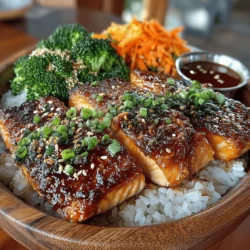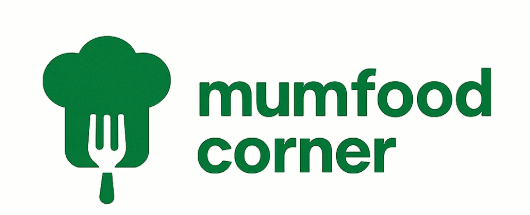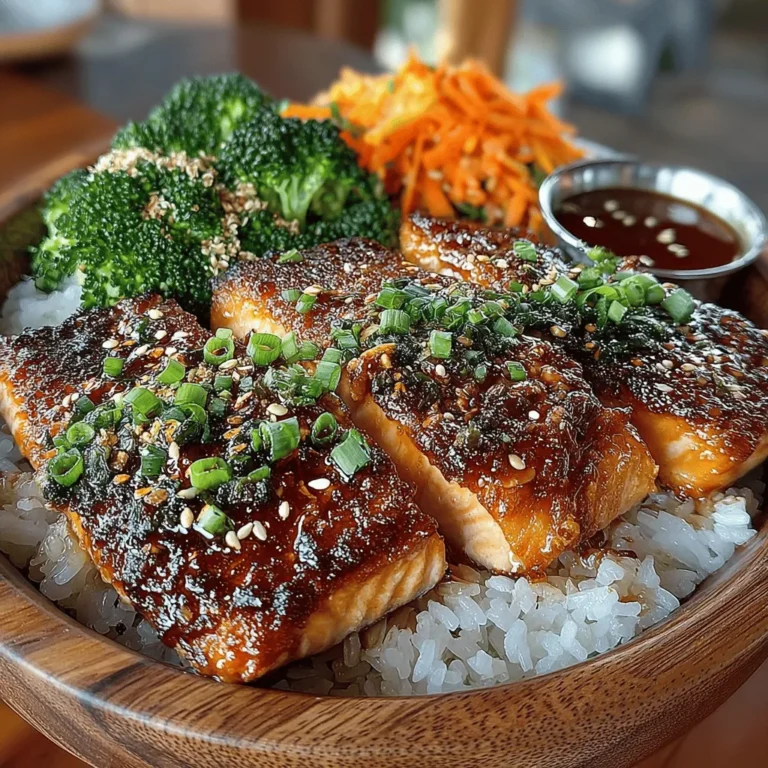Teriyaki flavors have captured the hearts and palates of food lovers around the globe. Originating from Japan, this glaze or sauce has become a staple in various cuisines, celebrated for its perfect balance of sweet and savory. The Quick Teriyaki Salmon Rice Bowl is an excellent example of how versatile and easy it can be to create a healthy meal option that doesn’t compromise on flavor. This dish is not only delicious but also offers a delightful combination of textures, making it a favorite among families and a superb choice for meal prep.
Ingredients
– 2 fresh salmon fillets
– 1/4 cup low-sodium soy sauce
– 2 tablespoons honey or maple syrup
– 1 tablespoon rice vinegar
– 1 teaspoon sesame oil
– 1 clove fresh ginger, minced
– 2 cloves garlic, minced
– 1 cup jasmine rice or brown rice
– 1 cup broccoli florets
– 1 medium carrot, sliced
– 2 green onions, chopped
– 1 tablespoon sesame seeds
Instructions
1. Prepare the Marinade: In a bowl, mix together the low-sodium soy sauce, honey or maple syrup, rice vinegar, sesame oil, minced ginger, and minced garlic. Ensure all ingredients are well combined for optimal flavor.
2. Marinate the Salmon: Place the salmon fillets in a shallow dish and pour the marinade over them. Cover and refrigerate for at least 30 minutes to allow the flavors to penetrate the fish.
3. Cook the Rice: Rinse the jasmine rice or brown rice under cold water. Cook according to package instructions, typically using a 2:1 water-to-rice ratio. Set aside when done.
4. Prepare the Vegetables: While the rice is cooking, steam the broccoli florets and sliced carrots until tender but still crisp, approximately 5-7 minutes.
5. Cook the Salmon: Heat a non-stick skillet over medium heat. Remove the salmon from the marinade, reserving the marinade for later. Cook the salmon for about 4-5 minutes on each side, or until it flakes easily with a fork. Add the reserved marinade to the skillet in the last minute of cooking to glaze the salmon.
6. Assemble the Bowls: In serving bowls, layer the cooked rice, steamed vegetables, and glazed salmon. Garnish with chopped green onions and sesame seeds for added flavor and presentation.
Understanding the Ingredients
Fresh Salmon Fillets
Salmon is renowned for its rich flavor and health benefits. Packed with omega-3 fatty acids, it supports heart health and provides high-quality protein. Its buttery texture and distinct taste make it a fantastic choice for a variety of dishes, especially teriyaki.
Low-Sodium Soy Sauce
Opting for low-sodium soy sauce is a smart choice for anyone looking to reduce their sodium intake without sacrificing flavor. It brings the necessary umami to the dish while allowing you to enjoy teriyaki’s deliciousness in a healthier way.
Honey or Maple Syrup
These natural sweeteners not only contribute to the sweetness of the teriyaki sauce but also offer health benefits. Honey is known for its antioxidant properties, while maple syrup contains essential minerals and vitamins.
Rice Vinegar and Sesame Oil
Rice vinegar adds a subtle acidity that balances the sweetness of the sauce, while sesame oil introduces a nutty aroma that is characteristic of authentic teriyaki dishes.
Fresh Ginger and Garlic
These two powerhouse ingredients not only enhance the flavor profile but also provide numerous health benefits, including anti-inflammatory properties and immune system support.
Overview of Additional Ingredients
Choosing between jasmine rice and brown rice can impact the nutritional value of your dish. Jasmine rice is fragrant and soft, while brown rice offers more fiber and nutrients. Including vegetables like broccoli and carrots not only boosts the dish’s nutritional content but also adds vibrant color and texture. Finally, the garnishes of green onions and sesame seeds elevate both the presentation and taste of the Quick Teriyaki Salmon Rice Bowl.

Preparing the Rice
Cooking fluffy jasmine rice is crucial for achieving the perfect texture in your Quick Teriyaki Salmon Rice Bowls. Start by rinsing the rice thoroughly under cold water to remove excess starch, which can make the rice sticky. Use a standard ratio of 1 cup of rice to 1.5 cups of water. Bring the water to a boil, then reduce to a simmer, cover, and let it cook for about 15 minutes. Once done, let the rice sit covered for an additional 10 minutes before fluffing it with a fork. This technique ensures that the grains remain separate and fluffy, providing a great base for your teriyaki salmon.
Assembling the Bowls
Presentation plays a vital role in creating an appealing meal. Start by layering a generous serving of fluffy jasmine rice in the bowl. Next, place the teriyaki salmon on top, allowing the glaze to drizzle down into the rice. Add a colorful array of steamed or sautéed vegetables, such as broccoli, bell peppers, and snap peas, around the salmon. Consider using a variety of colors to enhance the visual appeal. Finally, drizzle a little extra teriyaki sauce over the entire bowl for added flavor and garnish with sesame seeds and thinly sliced green onions to complete the presentation.
Garnishing
Enhance both the visual appeal and flavor profile of your Quick Teriyaki Salmon Rice Bowls with thoughtful garnishing. Fresh herbs, such as cilantro or basil, can add a burst of color and freshness. Sliced avocados or radishes not only increase the aesthetic but also contribute creaminess and crunch. For an added layer of flavor, consider sprinkling toasted sesame seeds or nori flakes. A squeeze of lime or lemon juice can brighten the dish and balance the sweetness of the teriyaki sauce.
Health Benefits of Teriyaki Salmon Rice Bowls
Nutritional Analysis
Quick Teriyaki Salmon Rice Bowls are not just delicious; they also offer a wealth of nutritional benefits. Salmon is an excellent source of high-quality protein, which is essential for muscle repair and growth. A typical serving contains around 22 grams of protein, making it a great option for active individuals.
Vitamins and Minerals from Vegetables and Rice
The vegetables in your rice bowl provide a variety of vitamins and minerals. For instance, broccoli is rich in vitamins C and K, while bell peppers offer a significant amount of vitamin A. Jasmine rice, while providing carbohydrates, also contains B vitamins that help in energy metabolism.
Healthy Fats from Salmon and Sesame Oil
Salmon is renowned for its omega-3 fatty acids, which are beneficial for heart health and brain function. Additionally, sesame oil, often used in teriyaki sauce, contains healthy fats that can support overall well-being. These healthy fats are integral to a balanced diet.
Overall Balanced Meal
This dish can fit seamlessly into various dietary lifestyles. For those focused on a balanced diet, the combination of protein, healthy fats, and carbohydrates provides sustained energy. For low-carb enthusiasts, consider substituting rice with cauliflower rice, maintaining the dish’s flavor while reducing carbohydrates.
Cultural Significance of Teriyaki Cuisine
Brief History of Teriyaki in Japanese Cuisine
Teriyaki, which translates to “grilled” or “broiled,” has its roots in Japanese cooking, where it was traditionally used to describe the technique of cooking fish and meats over an open flame, often brushed with a soy-based marinade.
Evolution and Integration into Western Cooking
Over the years, teriyaki has evolved and become a staple in Western cuisine, often modified to suit local palates. The sweet and savory flavor profile has made it a favorite in various fusion dishes, appealing to a wider audience.
Global Appeal and Adaptations
The global appeal of teriyaki dishes is evident in their numerous adaptations, from teriyaki chicken to vegetarian versions. This adaptability allows people from different cultures to enjoy and customize their teriyaki experiences.
Meal Prep and Storage Tips
Preparing Ingredients in Advance
To make your Quick Teriyaki Salmon Rice Bowls even more convenient, consider prepping ingredients in advance. Marinate the salmon the night before and chop vegetables ahead of time. Cook a larger batch of rice to use throughout the week.
Best Storage Practices for Leftovers
Store leftovers in airtight containers to maintain freshness. Salmon can typically be refrigerated for up to 3 days. If you need to keep it longer, consider freezing the cooked salmon and rice separately.
Reheating Tips
When reheating, microwave the salmon and rice on low power to prevent drying out. Adding a splash of water can help maintain moisture. Alternatively, reheat in a skillet over low heat, covering to retain steam and moisture.
Conclusion
Quick Teriyaki Salmon Rice Bowls are a fantastic choice for a nutritious and satisfying meal. Their ease of preparation, combined with the rich flavors and health benefits, make them an appealing option for busy weeknights. We encourage you to try this recipe and experience the delicious flavors and health benefits it offers. Incorporating easy, nutritious meals into your everyday life not only enhances your diet but also makes cooking enjoyable.


